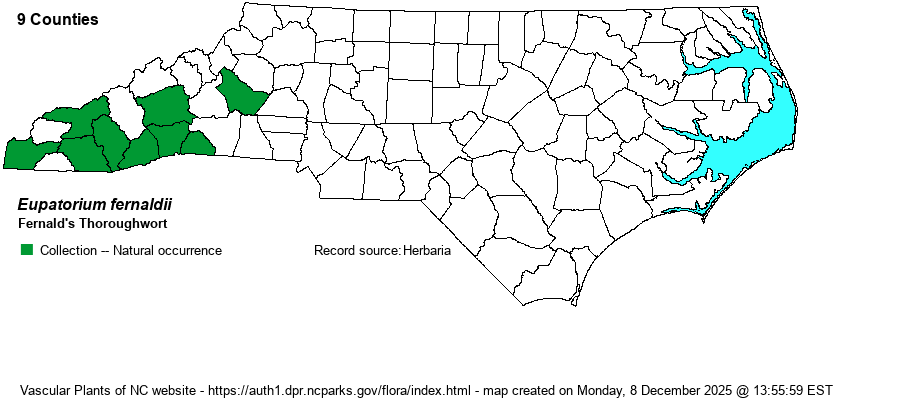| Author | Godfrey | |
| Distribution | Poorly known owing to taxonomic issues and unfamiliarity to most botanists. Apparently only in the low to mid-elevations in the southern Mountains/foothills.
"Sw. NC, nw. SC, and ne. GA; perhaps more widespread" (Weakley 2022). | |
| Abundance | Until a specimen was collected (NCU specimen) in Cherokee County in 2022 by Mark and Myra Basinger, and confirmed by Bruce Sorrie, all previously known specimens seemed to be from 1969 and older, which is why the NCNHP had given a State Rank of SH (Historical), and tracks records as Significantly Rare. In 2024, that agency re-ranked the species as S1 owing to the recent record. However, based on collections from 9 counties as of 2025, the species probably merits a rank of S1? if not S2?; the editors suggest S1S2 for now. There is little reason for most Eupatorium species to have become very rare over time, owing to their ability to grow on wooded margins, which are abundant. NatureServe has not yet given a Global Rank, and the editors suggest G2?. | |
| Habitat | Hardwood and pine-hardwood slope forests and woodlands, the soils mesic to moist. Probably favors wooded borders and openings, as most Eupatorium species favor some sunlight. | |
| Phenology | Flowering and fruiting late July-September. | |
| Identification | Leaves of Fernald's Thoroughwort are longer and taper to a longer point than other close relatives (like Godfrey's Thoroughwort [E. godfreyanum]), which reflects the length of leaves of two of its parents. The leaves are thus lanceolate in shape, serrated, and about 3-4 times longer than wide. In addition, its leaves have abundant resin dots (vs. sparse in Godfrey's Thoroughwort). | |
| Taxonomic Comments | Fernald's Boneset is an apomictic species, derived from hybrid E. perfoliatum x petaloideum x sessilifolium.
| |
| Other Common Name(s) | Fernald's Eupatorium, Fernald's Boneset | |
| State Rank | S1 [S1S2] | |
| Global Rank | GNR [G2?] | |
| State Status | SR-T | |
| US Status | | |
| USACE-agcp | | |
| USACE-emp | | |

